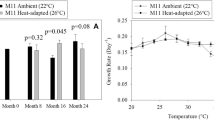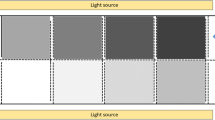Abstract
Copper is one of the most frequently used algaecides to control blooms of toxic cyanobacteria in water supply reservoirs. Among the negative impacts derived from the use of this substance is the increasing resistance of cyanobacteria to copper toxicity, as well as changes in the community structure of native phytoplankton. Here, we used the ratchet protocol to investigate the differential evolution and maximum adaptation capacity of selected freshwater phytoplankton species to the exposure of increasing doses of copper. Initially, a dose of 2.5 μM CuSO4·5H2O was able to completely inhibit growth in three strains of the toxic cyanobacterium Microcystis aeruginosa, whereas growth of the chlorophyceans Dictyosphaerium chlorelloides and Desmodesmus intermedius (represented by two different strains) was completely abolished at 12 μM. A significant increase in resistance was achieved in all derived populations during the ratchet experiment. All the chlorophyceans were able to adapt to up to 270 μM of copper sulfate, but 10 μM was the highest concentration that M. aeruginosa strains were able to cope with, although one of the replicates adapted to 30 μM. The recurrent use and increasing doses of copper in water reservoirs could lead to the selection of copper-resistant mutants of both chlorophyceans and cyanobacteria. However, under high concentrations of copper, the composition of phytoplankton community could undergo a drastic change with cyanobacteria being replaced by copper-resistant chlorophyceans. This result stems from a distinct evolutionary potential of these species to adapt to this substance.



Similar content being viewed by others
References
Andersen RA, Kawachi M (2005) Traditional microalgae isolation techniques. In: Andersen RA (ed) Algal culturing techniques. Elsevier, Amsterdam, pp 83–100
Atazadeh I, Kelly M, Sharifi M, Beardall J (2009) The effects of copper and zinc on biomass and taxonomic composition of algal periphyton communities from the River Gharasou, Western Iran. Oceanol Hydrobiol Stud 38:3–14. doi:10.2478/v10009-009-0027-3
Azevedo SM, Carmichael WW, Jochimsen EM, Rinehart KL, Lau S, Shaw GR, Eaglesham GK (2002) Human intoxication by microcystins during renal dialysis treatment in Caruaru-Brazil. Toxicology 181–182:441–446. doi:10.1016/S0300-483X(02)00491-2
Barón M, Arellano JB, Gorgé JL (1995) Copper and photosystem II: a controversive relationship. Physiol Plant 94:174–180. doi:10.1111/j.1399-3054.1995.tb00799.x
Belfiore NM, Anderson SL (2001) Effects of contaminants on genetic patterns in aquatic organisms: a review. Mutat Res 489:97–122. doi:10.1016/S1383-5742(01)00065-5
Blanck H, Dahl B (1996) Pollution-induced community tolerance (PICT) in marine periphyton in a gradient of tri-n-butyltin contamination. Aquat Toxicol 35:59–77. doi:10.1016/0166-445X(96)00007-0
Bossuyt BTA, Janssen CR (2004) Long-term acclimation of Pseudokirchneriella subcapitata (Korshikov) Hindak to different copper concentrations: changes in tolerance and physiology. Aquat Toxicol 68:61–74. doi:10.1016/j.aquatox.2004.02.005
Bradshaw AD, Hardwick K (1989) Evolution and stress: genotype and phenotype components. Biol J Linn Soc 37:137–155. doi:10.1111/j.1095-8312.1989.tb02099.x
Brand LE, Sunda WG, Guillard RRL (1986) Reduction of marine phytoplankton reproduction rates by copper and cadmium. J Exp Mar Biol Ecol 96:225–250. doi:10.1016/0022-0981(86)90205-4
Carmichael WW, Hui R (2006) Cyanobacteria toxins in the Salton Sea. Saline Syst 2:5. doi:10.1186/1746-1448-2-5
Carmichael WW, Azevedo SMFO, An JS, Molica RJR, Jochimsen EM, Lau S, Rinehart KL, Shaw GR, Eaglesham GK (2001) Human fatalities from cyanobacteria: chemical and biological evidence for cyanotoxins. Environ Health Perspect 109:663–668
Carrillo E, Ferrero LM, Alonso-Andicoberry C, Basanta A, Martín A, López-Rodas V, Costas E (2003) Interstrain variability in toxin production in populations of the cyanobacterium Microcystis aeruginosa from water-supply reservoirs of Andalusia and lagoons of Doñana National Park (southern Spain). Phycologia 42:269–274. doi:10.2216/i0031-8884-42-3-269.1
Chen J, Xie P, Li L, Xu J (2009a) First identification of the hepatotoxic microcystins in the serum of a chronically exposed human population together with indication of hepatocellular damage. Toxicol Sci 108:81–89. doi:10.1093/toxsci/kfp009
Chen J, Zhang DW, Xie P, Wang Q, Ma ZM (2009b) Simultaneous determination of microcystin contaminations in various vertebrates (fish, turtle, duck and water bird) from a large eutrophic Chinese lake, Lake Taihu, with toxic Microcystis blooms. Sci Total Environ 407:3317–3322. doi:10.1016/j.scitotenv.2009.02.005
Codd GA, Bell SG, Kaya K, Ward CJ, Beattie KA, Metcalf JS (1999) Cyanobacterial toxins, exposure routes and human health. Eur J Phycol 34:405–415. doi:10.1080/09670269910001736462
Cooper S (1991) Bacterial growth and division. Biochemistry and regulation of prokaryotic and eukaryotic division cycles. Academic, San Diego
Crow JF, Kimura M (1970) An introduction to population genetics theory. Harper and Row, New York
DalCorso G (2012) Heavy metals toxicity in plants. In: Furini A (ed) Plants and heavy metals. Springer briefs in molecular science. Springer, Dordrecht, pp 1–26
De Schamphelaere KAC, Stauber JL, Wilde KL, Markich SJ, Brown PL, Franklin NM, Creighton NM, Janssen CR (2005) Toward a biotic ligand model for freshwater green algae: surface-bound and internal copper are better predictors of toxicity than free Cu2+-ion activity when pH is varied. Environ Sci Technol 39:2067–2072. doi:10.1021/es049256l
Fogg GE (2001) Algal adaptation to stress: some general remarks. In: Rai LC, Gaur JP (eds) Algal adaptation to environmental stresses. Physiological biochemical and molecular mechanisms. Springer, Berlin, pp 1–20
García-Villada L, Rico M, Altamirano M, Sánchez-Martín L, López-Rodas V, Costas E (2004) Occurrence of copper resistant mutants in the toxic cyanobacteria Microcystis aeruginosa: characterization and future implications in the use of copper sulphate as algaecide. Water Res 38:2207–2213. doi:10.1016/j.watres.2004.01.036
Hadjoudja S, Vignoles C, Deluchat V, Lenaina J-F, Le Jeunea A-H, Baudu M (2009) Short term copper toxicity on Microcystis aeruginosa and Chlorella vulgaris using flow cytometry. Aquat Toxicol 94:255–264. doi:10.1016/j.aquatox.2009.07.007
Hall JL (2002) Cellular mechanisms for heavy metal detoxification and tolerance. J Exp Bot 53:1–11. doi:10.1093/jexbot/53.366.1
Hammer Ø, Harper DAT, Ryan PD (2001) PAST: Paleontological statistics software package for education and data analysis. Palaeontol Electron 4: 1–9. http://palaeo-electronica.org/2001_1/past/issue1_01.htm
Himelblau E, Amasino RM (2000) Delivering copper within plant cells. Curr Opin Plant Biol 3:205–210. doi:10.1016/S1369-5266(00)80066-7
Huertas IE, Rouco M, López-Rodas V, Costas E (2010) Estimating the capability of different phytoplankton groups to contamination: herbicides will affect phytoplankton species differently. New Phytol 188:478–487. doi:10.1111/j.1469-8137.2010.03370.x
Iannacone LR, Touchette BW (2008) A shift in phytoplankton dominance from cyanobacteria to chlorophytes following algaecide applications. In: Hudnell HK (ed) Cyanobacterial harmful algal blooms: State of the science and research needs. Springer, New York. Series: Adv Exp Med Biol 619:303–304. doi: 10.1007/978-0-387-75865-7
Jancula E, Marsalek B (2011) Critical review of actually available chemical compounds for prevention and management of cyanobacterial blooms. Chemosphere 85:1415–1422. doi:10.1016/j.chemosphere.2011.08.036
Lam AK-Y, Prepas EE, Spink D, Hrudey S (1995) Chemical control of hepatotoxic phytoplankton blooms: implications for human health. Water Res 29:1845–1854. doi:10.1016/0043-1354(94)00348-B
Le Jeune A-H, Charpin M, Deluchat V, Briand J-F, Lenain J-F, Baudu M, Amblard C (2006) Effect of copper sulphate treatment on natural phytoplankton communities. Aquat Toxicol 80:267–280. doi:10.1016/j.aquatox.2006.09.004
López-Rodas V, Maneiro E, Lanzarot MP, Perdigones N, Costas E (2008) Mass wildlife mortality due to cyanobacteria in the Doñana National Park, Spain. Vet Rec 162:317–318. doi:10.1136/vr.162.10.317
López-Rodas V, Rouco M, Sánchez-Fortún S, Flores-Moya A, Costas E (2011) Genetic adaptation and acclimation of phytoplankton along a stress gradient in the extreme waters of the Agrio River-Caviahue Lake (Argentina). J Phycol 47:1036–1043. doi:10.1111/j.1529-8817.2011.01035.x
Ma J (2005) Differential sensitivity of three cyanobacterial and five green algal species to organotins and pyrethroids pesticides. Sci Total Environ 341:109–117
Manara A (2012) Plant responses to heavy metal toxicity. In: Furini A (ed) Plants and heavy metals. Springer briefs in molecular science. Springer, Dordrecht, pp 27–54
Marvá F, López-Rodas V, Rouco M, Navarro M, Toro FJ, Costas E, Flores-Moya A (2010) Adaptation of green microalgae to the herbicides simazine and diquat as result of pre-selective mutations. Aquat Toxicol 96:130–134. doi:10.1016/j.aquatox.2009.10.009
Moore GT, Kellerman KF (1904) A method of destroying or preventing the growth of algae and certain pathogenic bacteria in water supplies. United States Department of Agriculture Bureau of Plant Industry Bulletin 64
Novick A, Szilard L (1950) Experiments with the chemostat on spontaneous mutations in bacteria. Proc Natl Acad Sci USA 36:708–719
Padovesi-Fonseca C, Philomeno MG (2004) Effects of algaecide (copper sulfate) application on short-term fluctuations of phytoplankton in Lake Paranoa, central Brazil. Braz J Biol 64:819–826
Pimentel D (1971) Ecological effects of pesticides on non-target species. Executive Office of the President’s Office of Science and Technology, Washington
Pinto E, Sigaud-Kutner TCS, Leitao MAS, Okamoto OK, Morse D, Colepicolo P (2003) Heavy metal-induced oxidative stress in algae. J Phycol 39:1008–1018. doi:10.1111/j.0022-3646.2003.02-193.x
Reboud X, Majerus N, Gasouez J, Powles S (2007) Chlamydomonas reinhardtii as a model system for pro-active herbicide resistance evolution research. Biol J Linn Soc 91:257–266. doi:10.1111/j.1095-8312.2007.00787.x
Romero-López J, López-Rodas V, Costas E (2012) Estimating the capability of microalgae to physiological acclimatization and genetic adaptation to petroleum and diesel oil contamination. Aquat Toxicol 124–125:227–237. doi:10.1016/j.aquatox.2012.08.001
Silver S (1996) Bacterial resistance to toxic metal ions-a review. Gene 179:9–19. doi:10.1016/S0378-1119(96)00323-X
Sivonen K, Jones G (1999) Cyanobacterial toxins. In: Chorus I, Bartram J (eds) Cyanobacteria in water: a guide to public health significance, monitoring and management. Routledge, London, pp 41–111
Soldo D, Behra R (2000) Long-term effects of copper on the structure of freshwater periphyton communities and their tolerance to copper, zinc, nickel and silver. Aquat Toxicol 47:181–189. doi:10.1016/S0166-445X(99)00020-X
Takamura N, Kasai F, Watanabe MM (1989) Effects of Cu, Cd and Zn on photosynthesis of freshwater benthic algae. J Appl Phycol 1:39–52. doi:10.1007/BF00003534
Takamura N, Kasai F, Watanabe MM (1990) Unique response of Cyanophyceae to copper. J Appl Phycol 2:293–296. doi:10.1007/BF02180917
Tripathi BN, Mehta Anshu Amar SK, Gaur JP (2006) Oxidative stress in Scenedesmus sp. during short- and long-term exposure to Cu2+ and Zn2+. Chemosphere 62:538–544. doi:10.1016/j.chemosphere.2005.06.031
Twiss MR, Rattan KJ, Sherrell RM, McKay RML (2004) Sensitivity of phytoplankton to copper in Lake Superior. J Gt Lakes Res 30(suppl. 1):245–255. doi:10.1016/S0380-1330(04)70389-5
Van Hullebusch E, Deluchat V, Chazal PhM, Baudu M (2002) Environmental impact of two successive chemical treatments in a small shallow eutrophied lake: (II) case of copper sulfate. Environ Pollut 120:627–634. doi:10.1016/S0269-7491(02)00191-4
Wu ZX, Gan NQ, Huang Q, Song LR (2007) Response of Microcystis to copper stress: do phenotypes of Microcystis make a difference in stress tolerance? Environ Pollut 147:324–330. doi:10.1016/j.envpol.2006.05.022
Zeng J, Yang L, Wang WX (2010) High sensitivity of cyanobacterium Microcystis aeruginosa to copper and the prediction of copper toxicity. Environ Toxicol Chem 29:2260–2268. doi:10.1002/etc.266
Acknowledgments
This work has been financially supported by the Spanish Ministry of Science and Innovation through the Grants CTM2008-05680 C02-01/MAR, CGL2008-00652/BOS and by Junta de Andalucía Research Group RNM-115. Special thanks are given to Lara de Miguel Fernández for technical support. Dr. Eric C. Henry kindly revised the English style and usage. The suggestions and criticisms of two anonymous reviewers are deeply acknowledged.
Author information
Authors and Affiliations
Corresponding author
Additional information
Communicated by Elena Litchman.
Rights and permissions
About this article
Cite this article
Rouco, M., López-Rodas, V., González, R. et al. The limit of the genetic adaptation to copper in freshwater phytoplankton. Oecologia 175, 1179–1188 (2014). https://doi.org/10.1007/s00442-014-2963-1
Received:
Accepted:
Published:
Issue Date:
DOI: https://doi.org/10.1007/s00442-014-2963-1




